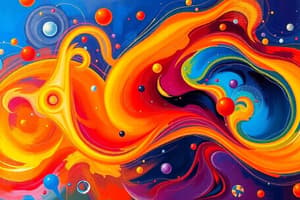Podcast
Questions and Answers
What term describes a substance whose temperature is below the saturation temperature corresponding to its pressure?
What term describes a substance whose temperature is below the saturation temperature corresponding to its pressure?
- Saturated liquid
- Wet vapor
- Subcooled liquid (correct)
- Superheated vapor
The constant number of molecules in a mole of any substance is known as what?
The constant number of molecules in a mole of any substance is known as what?
- Avogadro's number (correct)
- Rankine constant
- Otto constant
- Thompson constant
According to which law is the volume of a gas directly proportional to its absolute temperature when pressure is held constant?
According to which law is the volume of a gas directly proportional to its absolute temperature when pressure is held constant?
What condition describes the situation where a liquid and its vapor are indistinguishable?
What condition describes the situation where a liquid and its vapor are indistinguishable?
When a gas is below its critical temperature, it is referred to as what?
When a gas is below its critical temperature, it is referred to as what?
What is the enthalpy change of an ideal gas when compressed isothermally?
What is the enthalpy change of an ideal gas when compressed isothermally?
Which thermodynamic cycle is recognized as the most efficient?
Which thermodynamic cycle is recognized as the most efficient?
What does the equation $C_p = C_v + R$ specifically apply to?
What does the equation $C_p = C_v + R$ specifically apply to?
What defines an adiabatic process?
What defines an adiabatic process?
In which scenario does an ideal gas experience an increase in temperature?
In which scenario does an ideal gas experience an increase in temperature?
What does mean effective pressure refer to?
What does mean effective pressure refer to?
What characterizes a control volume in thermodynamics?
What characterizes a control volume in thermodynamics?
Which of these cycles consists of two isothermal and two constant volume processes?
Which of these cycles consists of two isothermal and two constant volume processes?
Flashcards
Enthalpy of Ideal Gas
Enthalpy of Ideal Gas
The enthalpy of an ideal gas is solely determined by its temperature. It's independent of pressure, entropy, or internal energy.
Most Efficient Thermodynamic Cycle
Most Efficient Thermodynamic Cycle
The Carnot cycle is the theoretical most efficient thermodynamic cycle, achieving maximum efficiency while transferring heat between two reservoirs at different temperatures.
First Law of Thermodynamics
First Law of Thermodynamics
The first law of thermodynamics states that energy can neither be created nor destroyed, only transformed from one form to another.
Enthalpy Change During Isothermal Compression
Enthalpy Change During Isothermal Compression
Signup and view all the flashcards
Adiabatic Process
Adiabatic Process
Signup and view all the flashcards
Temperature Change in Adiabatic Compression
Temperature Change in Adiabatic Compression
Signup and view all the flashcards
Mean Effective Pressure
Mean Effective Pressure
Signup and view all the flashcards
Stirling Cycle
Stirling Cycle
Signup and view all the flashcards
Subcooled Liquid
Subcooled Liquid
Signup and view all the flashcards
Avogadro's Number
Avogadro's Number
Signup and view all the flashcards
Charles' Law
Charles' Law
Signup and view all the flashcards
Atomic Number
Atomic Number
Signup and view all the flashcards
Critical Point
Critical Point
Signup and view all the flashcards
Study Notes
Thermodynamics and Basic Concepts
-
Enthalpy of an ideal gas: A function solely of temperature. (Option C)
-
Most efficient thermodynamic cycle: The Carnot cycle. (Option C)
-
First Law of Thermodynamics: Energy cannot be created or destroyed. (Option C)
-
Isothermal compression of an ideal gas: Enthalpy change is zero. (Option C)
-
Process with no heat transfer: Adiabatic process. (Option D)
-
Adiabatic compression of an ideal gas: Temperature increases. (Option B)
-
SI unit of pressure: Pascal. (Option C)
-
Relationship between Cp and Cv for an ideal gas: Cp = Cv + R. (Option B)
-
Integral of Vdp in a flow process: Represents flow energy/enthalpy change. (Option C)
-
Mechanical energy to heat conversion: Heat Exchanger/Heat of compression (Option C)
-
Theory of heat to mechanical work: Thermodynamics (Option A)
-
Average pressure under varying pressure: Mean effective pressure (Option D)
-
Cycle with two isothermal and two constant volume processes: Stirling cycle. (Option C)
-
Control volume: A fixed region in space. (Option A)
-
Polytropic process with infinitely large n: Isobaric process. (Option A)
-
Constant temperature, increased pressure beyond saturation: Compressed liquid. (Option B)
-
Substance below saturation temperature and pressure: Subcooled liquid. (Option C)
-
Number of molecules per mole: Avogadro's number. (Option B)
-
Constant pressure, volume's relationship to temperature: Charles' law. (Option C)
-
Number of protons/electrons in an atom: Atomic number. (Option B)
-
P-T diagram - solid/liquid phase separation: Fusion curve. (Option B)
-
18°F to °C conversion: -9.44°C (Option D)
-
Latent heat of vaporization in joules/kg: Values varied, need specific context. (Option not provided)
-
Form of energy from molecular motion: Internal energy. (Option A)
-
Constant temperature, increased pressure beyond saturation: Compressed liquid. (Option B)
-
Liquid/vapor indistinguishable condition: Critical point. (Option A)
-
Gaseous substance below critical temperature: Vapor. (Option A)
-
Superheated vapor behavior: Approximately like a gas. (Option D)
Additional Concepts
- Cycles: Brayton, Otto, Diesel (listed for context).
- States of matter: Vapor, liquid, solid (mentioned in context).
- Units: kg/cm², dynes/cm², Psi, Pascal (listed for context).
Studying That Suits You
Use AI to generate personalized quizzes and flashcards to suit your learning preferences.




